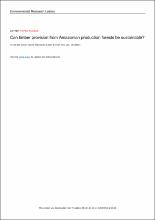Por favor, use este identificador para citar o enlazar este ítem:
https://hdl.handle.net/20.500.12921/446| Título : | Can timber provision from Amazonian production forests be sustainable? |
| Autor : | Piponiot, Camille Rödig, Edna Putz, Francis E. Rutishauser, Ervan Sist, Plinio Ascarrunz, Nataly Carneiro Guedes, Marcelino Ascarrunz, Nataly Blanc, Lilian Derroire, Géraldine Honorio Coronado, Eurídice Huth, Andreas Kanashiro, Milton Licona, Juan Carlos Mazzei, Lucas Neves d’Oliveira, Marcus Vinicio Peña-Claros, Marielos Rodney, Ken Shenkin, Alexander Rodrigues de Souza, Cintia Vidal, Edson PWest, Thales A. Wortel, Verginia Hérault, Bruno |
| Palabras clave : | Bosque tropical Madera tropical Producción de madera Política forestal Gestión forestal sostenible Restauración del paisaje forestal Amazonía |
| Fecha de publicación : | jun-2019 |
| Editorial : | IOP Publishing |
| Citación : | Piponiot, C., Rödig, E., Putz, F. E., Rutishauser, E., Sist, P., Ascarrunz, N., ... & Hérault, B. (2019). Can timber provision from Amazonian production forests be sustainable?. Environmental Research Letters, 14(6), 064014. |
| Resumen : | Around 30 Mm3 of sawlogs are extracted annually by selective logging of natural production forests in Amazonia, Earth's most extensive tropical forest. Decisions concerning the management of these production forests will be of major importance for Amazonian forests' fate. To date, no regional assessment of selective logging sustainability supports decision-making. Based on data from 3500 ha of forest inventory plots, our modelling results show that the average periodic harvests of 20 m3 ha−1 will not recover by the end of a standard 30 year cutting cycle. Timber recovery within a cutting cycle is enhanced by commercial acceptance of more species and with the adoption of longer cutting cycles and lower logging intensities. Recovery rates are faster in Western Amazonia than on the Guiana Shield. Our simulations suggest that regardless of cutting cycle duration and logging intensities, selectively logged forests are unlikely to meet timber demands over the long term as timber stocks are predicted to steadily decline. There is thus an urgent need to develop an integrated forest resource management policy that combines active management of production forests with the restoration of degraded and secondary forests for timber production. Without better management, reduced timber harvests and continued timber production declines are unavoidable. |
| URI : | https://hdl.handle.net/20.500.12921/446 |
| ISSN : | 1877-7260 |
| Aparece en las colecciones: | Artículos en revistas indexadas |
Ficheros en este ítem:
| Fichero | Descripción | Tamaño | Formato | |
|---|---|---|---|---|
| Piponiot _articulo_2019.pdf Until 2039-12-01 | Texto Completo | 1,25 MB | Adobe PDF |  Visualizar/Abrir Request a copy |
Compartir :
Este ítem está sujeto a una licencia Creative Commons Licencia Creative Commons




